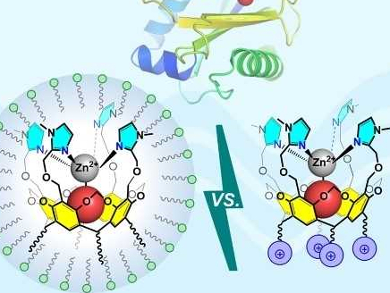Molecular recognition in water is a topic of increasing interest. It is challenging task due to the competitive nature of water. Olivia Reinaud, Paris Descartes University, France, Kristin Bartik, Université Libre de Bruxelles, Belgium, and colleagues have compared two different strategies for the water solubilization of a biomimetic metallo‐receptor based on a poly(imidazole) resorcinarene core:
a) The first strategy (pictured left) involves the incorporation of the organosoluble metallo‐receptor into dodecylphosphocholine (DPC) micelles. The micelles mimic the protein surrounding of the active site of metallo‐enzymes.
b) The second strategy (pictured right) relies on a new synthetic path for the introduction of hydrophilic substituents on the receptor, at a remote distance from the coordination site. The substituents make the receptor water soluble.
The resorcinarene ligand can be transferred into water through both strategies. Both methods allowed the team to obtain excellent receptors for small hydrophilic organic guests bound into the cavity and coordinated to the metal ion (Zn(II)) as anions. Surprisingly, the binding constants and pH responses of and to the metal ion are very similar. These results show that, provided the receptor is well structured, the micellar environment has very little impact on either metal ion binding or guest hosting. Hence, micellar incorporation represents an easy alternative to difficult synthetic work, even for the binding of charged species. According to the researchers, this opens new perspectives for molecular recognition in water for sensing, transport, or catalysis.
- Submerging a Biomimetic Metallo-Receptor in Water for Molecular Recognition: Micellar Incorporation or Water Solubilization? A Case Study,
Solène Collin, Arnaud Parrot, Lionel Marcelis, Emilio Brunetti, Ivan Jabin, Gilles Bruylants, Kristin Bartik, Olivia Reinaud,
Chem. Eur. J. 2018, 24, 17964–17974.
https://doi.org/10.1002/chem.201804768




